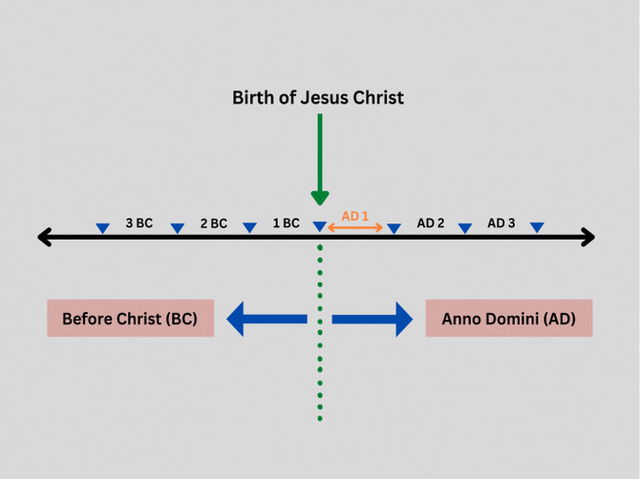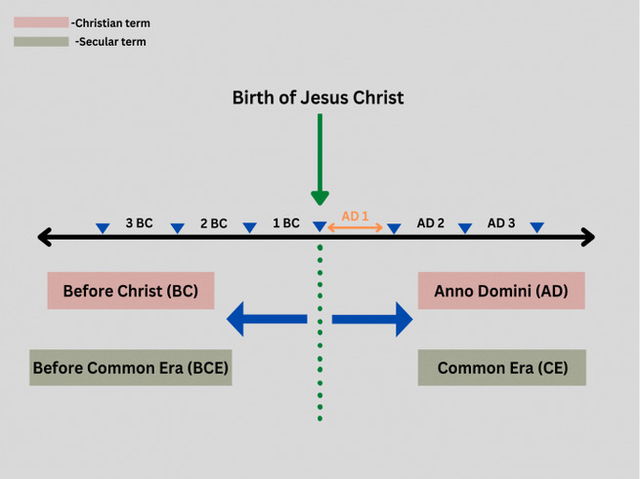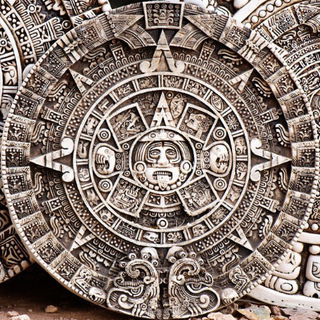BC and AD are labels used to count the number of years. BC means ' Before Christ ' and AD stands for ' Anno Domini ', a Latin term which means 'Year of Our Lord' in English.
The BC/AD dating system was created with respect to the birthdate of Jesus Christ, which is considered the central starting point. As the name suggests, BC or Before Christ refers to the number of years before Christ was born. AD or Anno Domini is the period after Christ was born.
BCE and CE stand for 'Before Common Era' and 'Common Era' and are alternatives to BC and AD respectively.

Historical Origin
A Christian monk named Dionysius Exiguus was the first person who came up with the idea of dividing the timeline based on the birth of Christ.
Before the BC/AD system was started, the years were named after the Roman emperor Diocletian during the Diocletian era. He had persecuted countless Christians during his reign. Dionysius thus wished to eliminate this system and consequently the memory of the emperor. This is why he came up with the AD system in the year 525. The BC dating system was not yet created during that time.
The Anno Domini system (also known as the Christian or Dionysian period) soon began to be known all over Europe. However, it was not until the 8th century that its popularity peaked.
During this time, another English monk named Bede used this dating system in his book 'Ecclesiastical History of the English People'. It not only helped to further increase the popularity of the AD system but also introduced the concept of BC.
It is important to note that Bede did not directly use the term 'Before Christ'. He just mentioned the period before Christ was born during one instance. In fact, the term 'Before Christ' did not come into existence until much later.
Origins of the AD/BC format
Generally, the year number is written after AD and before BC. For example, AD 1 means the year Christ was born. 1 BC, on the other hand, is the year before that.
The AD/BC dating system is used in the Gregorian Calendar. The Gregorian calendar was started by Pope Gregory XIII in the year 1577. It uses the labels AD and BC to mark the years. Although it originated in the Western Christian religion, the Gregorian calendar is now accepted and used all over the world.
There is no year zero in the calendar. This is because people in Western Europe were not yet aware of the concept of zero during that time. Thus, the calendar jumps straight from 1 BC to AD 1.
What BCE and CE mean, and how they differ from BC/AD
BCE and CE stand for 'Before Common Era' and 'Common Era' respectively. The former means the same as BC and the latter is the same as AD. Thus, AD 1 and 1 CE mean the same year. These terms were first used during the 17th century.

Please note that, unlike the BC/AD system, the new system follows a format where both BCE and CE are written after the year.
Why was the BCE/CE system created?
The traditionally used labels BC and AD were replaced with BCE and CE for the sake of including all religions.
The Jewish academics were the first ones to adopt this system and have been using it for over a hundred years. They argued that the BC/AD system was controversial because its origin was rooted in Christianity. Since the Gregorian calendar had assumed a level of international importance, they decided that it might be offensive to people who are not Christians.
Another reason for adopting this system was because of an error in the birthdate of Jesus Christ. Many believed that Christ was actually born two years before AD 1. In that case, the AD/BC system would be inaccurate.
The BCE/CE system was more suitable in this regard. This was because it did not refer to any particular date as the birth date of Jesus. However, it still followed the general rule and used 1 CE (or AD 1) as its starting point.
The terms CE and BCE surfaced during the 'Vulgar era' in the 17th century. However, the definition of vulgar does not correspond to the modern-day word meaning crude or indecent. Instead, it is derived from the Latin word 'Vulgaris' meaning ordinary or common. Thus, this era was named keeping the common people in mind.
Use of BC and AD dating system
Although the BCE/CE dating system has been developed as an alternative to the BC/AD system, the latter is still widely used throughout the world.
As per statistics, most people who object to the new system do so because they believe that the importance of Jesus Christ is being erased.
Others justify it by saying that developing a secular dating system makes no sense since the Gregorian calendar is supposed to be a Christian Calendar itself.
Moreover, some people also argue that both these systems might cause confusion among people. Thus, you can use the dating system that you prefer the most.
Lesser known dating systems
While the most recognized dating systems are BC (Before Christ) and AD (Anno Domini), there are several lesser-known dating systems that have their own uses in different contexts and cultures across the world:
- BP: Before Present (sometimes written as YBP: Years Before Present) - mostly an archeological and geological term, to date things relative to the birth of carbon dating which was 1950 (the 'present day').
- MYA: Million Years Ago - A system used by paleontologists and geologists, often when dealing with vast periods of time.
- YA: Years Ago
- AH: After Hijrah (Islamic calendar) - this term, as well as the term BH (Before Hijrah) is used to describe a period of time in relation to Hijrah, Muhammad's migration from Mecca to Yathrib.
- AM: Anno Mundi (Hebrew calendar) - this term translates as after creation, and is used by the Jewish community to measure time in the Hebrew calendar.
Hey! Hope you enjoyed this article. Just so you know, it's been sponsored by Texxto.ai, a really cool AI-powered tool that rewrites and improves your texts with one click. Just by signing up, you get 3 free daily uses!
>>> Get Your Texxto.ai Free Account Now! >>>
If you found this article interesting, you might like to read these next:











